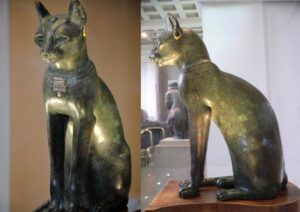1. Introduction to the Gayer-Anderson Cat
The Gayer-Anderson Cat, a captivating bronze statue dating back to around 600 BC, is one of the finest examples of ancient Egyptian artistry. Discovered in Egypt and now preserved at the British Museum, this statue holds a significant place in the representation of Egyptian culture, spirituality, and symbolism. Named after Major Robert Grenville Gayer-Anderson, who donated it to the museum, this piece of art provides insights into the Egyptians’ reverence for cats and the goddess Bastet, who embodied protection, fertility, and domestic harmony.
2. Historical and Cultural Background
- The Role of Cats in Egyptian Society
In ancient Egypt, cats were not just pets but revered as protectors of households. They were seen as creatures with divine connections, believed to ward off evil and safeguard the family. Cats were so cherished that harming them was considered a grave offense, punishable by law. They were valued not only for their hunting skills in keeping homes rodent-free but also for their association with the goddess Bastet. - Bastet: The Goddess of Home and Protection
Bastet, often depicted as a lioness or a domestic cat, was the goddess of home, fertility, and protector of women and children. Her influence extended to protection against disease and evil spirits. The Egyptians celebrated her with festivals, and her temple in Bubastis was among the most popular pilgrimage sites. Bastet’s association with cats made these animals divine figures and protectors, embodying her attributes in physical form.
3. Artistic Features and Craftsmanship
- Bronze Casting Techniques and Symbolism
The Gayer-Anderson Cat is a masterpiece of bronze craftsmanship, showcasing techniques that Egyptian artisans had refined over centuries. Cast in bronze and decorated with detailed engravings, the statue highlights the Egyptians’ skills in metalwork. Bronze, a valuable material, was used selectively for items of spiritual or ceremonial significance. By using this material, the statue was likely intended for a high-ranking individual or a temple, further reflecting the cultural importance of the figure it represents. - Intricate Decorations and Symbolic Jewelry
The cat is adorned with various pieces of jewelry, including a collar, earrings, and a scarab-shaped amulet on its chest. Each of these elements has symbolic significance:- Scarab Amulet: The scarab, a symbol of rebirth and protection, was placed on the cat’s chest, amplifying its role as a guardian.
- Collar and Earrings: The cat’s ornate collar and earrings represent wealth, status, and reverence, symbolizing the cat’s link to Bastet’s nobility. These intricate details capture both the elegance of the feline form and the protective qualities associated with Bastet, imbuing the statue with a sense of spiritual power.

4. Symbolism and Spiritual Significance
- Cats as Guardians and Spiritual Symbols
In Egyptian culture, cats represented both the physical and spiritual protection of the household. Cats were thought to possess the ability to sense invisible dangers and repel negative forces, making them protectors of the family. The Gayer-Anderson Cat’s vigilant stance and detailed adornments underscore this symbolism, reflecting the ancient Egyptians’ belief in the cat’s powerful guardian spirit. - Reflection of Egyptian Beliefs in the Statue
The statue’s alert posture and finely crafted details symbolize the Egyptians’ belief in a harmonious connection between the spiritual and physical worlds. By embodying Bastet’s attributes, the Gayer-Anderson Cat was more than a statue; it was a physical manifestation of divine protection. In life and art, Egyptians blurred the lines between the mortal and divine realms, and this statue serves as a reminder of that fluidity.
5. Artistic Legacy and Influence
- Influence on Later Egyptian Art and Culture
The Gayer-Anderson Cat is a prime example of how Egyptian art sought to capture more than just physical likenesses. Egyptian sculptures and artifacts were designed to convey deeper, spiritual meanings, a legacy that influenced later art forms, including Roman-Egyptian iconography and Coptic Christian art. This emphasis on symbolic representation, seen in the Gayer-Anderson Cat, paved the way for the integration of spirituality in visual art across centuries. - Modern Appreciation and Cultural Impact
Today, the Gayer-Anderson Cat remains a highlight of the British Museum, drawing visitors fascinated by ancient Egypt’s complex spiritual beliefs and artistic skill. Beyond its historical context, this statue has inspired modern artists, historians, and spiritual seekers who find meaning in its symbolism. Its enduring appeal reminds us of the universal themes of protection, connection to nature, and reverence for the unseen that continue to resonate in modern society.
6. Conclusion: A Window into Ancient Egypt’s Spirit
The Gayer-Anderson Cat is more than a remarkable bronze sculpture; it is a window into the spiritual and artistic legacy of ancient Egypt. From its intricately crafted details to its powerful symbolism, the statue embodies the Egyptian ideal of harmony between the natural and divine worlds. Revered as a guardian and a representation of Bastet, this artifact offers a profound glimpse into a civilization that saw the sacred in everyday life and found beauty in the natural order. The Gayer-Anderson Cat stands today not only as a work of art but as a timeless symbol of the Egyptians’ spiritual devotion and artistic mastery.
